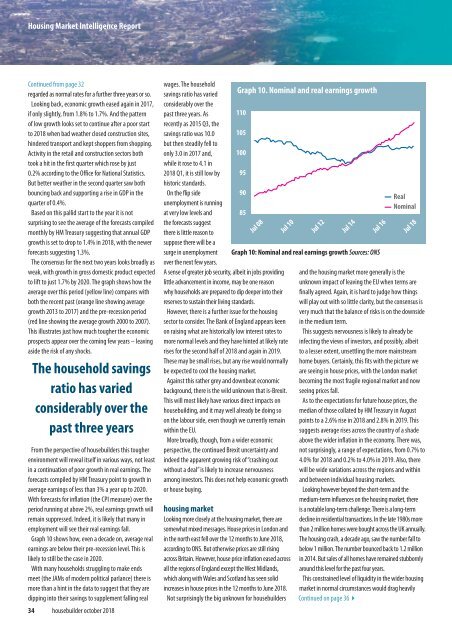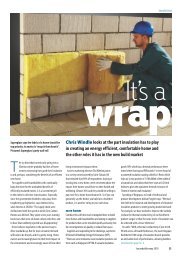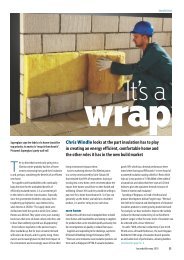Housebuilder October 2018
Create successful ePaper yourself
Turn your PDF publications into a flip-book with our unique Google optimized e-Paper software.
Housing Market Intelligence Report<br />
Continued from page 32<br />
regarded as normal rates for a further three years or so.<br />
Looking back, economic growth eased again in 2017,<br />
if only slightly, from 1.8% to 1.7%. And the pattern<br />
of low growth looks set to continue after a poor start<br />
to <strong>2018</strong> when bad weather closed construction sites,<br />
hindered transport and kept shoppers from shopping.<br />
Activity in the retail and construction sectors both<br />
took a hit in the first quarter which rose by just<br />
0.2% according to the Office for National Statistics.<br />
But better weather in the second quarter saw both<br />
bouncing back and supporting a rise in GDP in the<br />
quarter of 0.4%.<br />
Based on this pallid start to the year it is not<br />
surprising to see the average of the forecasts compiled<br />
monthly by HM Treasury suggesting that annual GDP<br />
growth is set to drop to 1.4% in <strong>2018</strong>, with the newer<br />
forecasts suggesting 1.3%.<br />
The consensus for the next two years looks broadly as<br />
weak, with growth in gross domestic product expected<br />
to lift to just 1.7% by 2020. The graph shows how the<br />
average over this period (yellow line) compares with<br />
both the recent past (orange line showing average<br />
growth 2013 to 2017) and the pre-recession period<br />
(red line showing the average growth 2000 to 2007).<br />
This illustrates just how much tougher the economic<br />
prospects appear over the coming few years – leaving<br />
aside the risk of any shocks.<br />
The household savings<br />
ratio has varied<br />
considerably over the<br />
past three years<br />
From the perspective of housebuilders this tougher<br />
environment will reveal itself in various ways, not least<br />
in a continuation of poor growth in real earnings. The<br />
forecasts compiled by HM Treasury point to growth in<br />
average earnings of less than 3% a year up to 2020.<br />
With forecasts for inflation (the CPI measure) over the<br />
period running at above 2%, real earnings growth will<br />
remain suppressed. Indeed, it is likely that many in<br />
employment will see their real earnings fall.<br />
Graph 10 shows how, even a decade on, average real<br />
earnings are below their pre-recession level. This is<br />
likely to still be the case in 2020.<br />
With many households struggling to make ends<br />
meet (the JAMs of modern political parlance) there is<br />
more than a hint in the data to suggest that they are<br />
dipping into their savings to supplement falling real<br />
34 housebuilder october <strong>2018</strong><br />
wages. The household<br />
savings ratio has varied<br />
considerably over the<br />
past three years. As<br />
110<br />
recently as 2015 Q3, the<br />
savings ratio was 10.0 105<br />
but then steadily fell to<br />
only 3.0 in 2017 and, 100<br />
while it rose to 4.1 in<br />
<strong>2018</strong> Q1, it is still low by 95<br />
historic standards.<br />
On the flip side<br />
90<br />
unemployment is running<br />
at very low levels and<br />
85<br />
the forecasts suggest<br />
there is little reason to<br />
suppose there will be a<br />
surge in unemployment<br />
over the next few years.<br />
A sense of greater job security, albeit in jobs providing<br />
little advancement in income, may be one reason<br />
why households are prepared to dip deeper into their<br />
reserves to sustain their living standards.<br />
However, there is a further issue for the housing<br />
sector to consider. The Bank of England appears keen<br />
on raising what are historically low interest rates to<br />
more normal levels and they have hinted at likely rate<br />
rises for the second half of <strong>2018</strong> and again in 2019.<br />
These may be small rises, but any rise would normally<br />
be expected to cool the housing market.<br />
Against this rather grey and downbeat economic<br />
background, there is the wild unknown that is-Brexit.<br />
This will most likely have various direct impacts on<br />
housebuilding, and it may well already be doing so<br />
on the labour side, even though we currently remain<br />
within the EU.<br />
More broadly, though, from a wider economic<br />
perspective, the continued Brexit uncertainty and<br />
indeed the apparent growing risk of “crashing out<br />
without a deal” is likely to increase nervousness<br />
among investors. This does not help economic growth<br />
or house buying.<br />
Jul 08<br />
Jul 10<br />
housing market<br />
Looking more closely at the housing market, there are<br />
somewhat mixed messages. House prices in London and<br />
in the north east fell over the 12 months to June <strong>2018</strong>,<br />
according to ONS. But otherwise prices are still rising<br />
across Britain. However, house price inflation eased across<br />
all the regions of England except the West Midlands,<br />
which along with Wales and Scotland has seen solid<br />
increases in house prices in the 12 months to June <strong>2018</strong>.<br />
Not surprisingly the big unknown for housebuilders<br />
Graph 10. Nominal and real earnings growth<br />
Jul 12<br />
Jul 14<br />
Graph 10: Nominal and real earnings growth Sources: ONS<br />
Jul 16<br />
Real<br />
Nominal<br />
Jul 18<br />
and the housing market more generally is the<br />
unknown impact of leaving the EU when terms are<br />
finally agreed. Again, it is hard to judge how things<br />
will play out with so little clarity, but the consensus is<br />
very much that the balance of risks is on the downside<br />
in the medium term.<br />
This suggests nervousness is likely to already be<br />
infecting the views of investors, and possibly, albeit<br />
to a lesser extent, unsettling the more mainstream<br />
home buyers. Certainly, this fits with the picture we<br />
are seeing in house prices, with the London market<br />
becoming the most fragile regional market and now<br />
seeing prices fall.<br />
As to the expectations for future house prices, the<br />
median of those collated by HM Treasury in August<br />
points to a 2.6% rise in <strong>2018</strong> and 2.8% in 2019. This<br />
suggests average rises across the country of a shade<br />
above the wider inflation in the economy. There was,<br />
not surprisingly, a range of expectations, from 0.7% to<br />
4.0% for <strong>2018</strong> and 0.2% to 4.0% in 2019. Also, there<br />
will be wide variations across the regions and within<br />
and between individual housing markets.<br />
Looking however beyond the short-term and the<br />
medium-term influences on the housing market, there<br />
is a notable long-term challenge. There is a long-term<br />
decline in residential transactions. In the late 1980s more<br />
than 2 million homes were bought across the UK annually.<br />
The housing crash, a decade ago, saw the number fall to<br />
below 1 million. The number bounced back to 1.2 million<br />
in 2014. But sales of all homes have remained stubbornly<br />
around this level for the past four years.<br />
This constrained level of liquidity in the wider housing<br />
market in normal circumstances would drag heavily<br />
Continued on page 36







